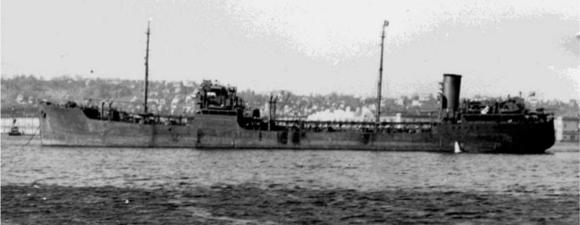 At about 9AM on January 15, 1942, the British tanker Coimbra, bound from Bayonne, NJ for Halifax, laden with 8,038 tons of lubricating oil, sank after being struck by two torpedoes fired by the German submarine U-123 off the southern shore of Long Island. Thirty-six of the 46 people aboard the tanker died.
At about 9AM on January 15, 1942, the British tanker Coimbra, bound from Bayonne, NJ for Halifax, laden with 8,038 tons of lubricating oil, sank after being struck by two torpedoes fired by the German submarine U-123 off the southern shore of Long Island. Thirty-six of the 46 people aboard the tanker died.
Oil still trapped in the tanks of the sunken British tanker began leaking noticeably four years ago, creating a visible sheen above the wreck, which is in 185 feet of water, 30 miles off Long Island’s south shore. To address the environmental hazard, last May, divers supervised by the US Coast Guard began to remove the oil from eight tanks on the ship,
Newsday reports that a unified command consisting of the DEC and the Coast Guard oversaw the oil removal supported by more than 100 specialists from government, industry and environmental concerns. The project was accomplished with the assistance of a 6,000-pound remotely operated underwater vehicle.
By the middle of July, the divers had successfully removed 450,000 gallons of oil.
WWII Ship Wreck Discovered Near New York
Captain Reinhard Hardegen was in command of the U-123 when she sank the Coimbra. Captain Hardegen was one of the most successful German submarine commanders during World War II, sinking 22 merchant ships with a capacity of 115,656 GRT, over five patrols. After the war, he started a successful oil trading business and served as a member of Bremen’s city council for over 32 years. He was also the longest surviving U-boat captain, dying at the age of 105 last year. See our post, The Last U-Boat Captain, Reinhard Hardegen, & the Tanker Coimbra.

On the presumption that a gallon of the oil weighs 6.85 pounds. So far they have only recovered around 1,541 tons. Or about (just over) on fifth of the load. Good lord that is alot of sewing machine oil.
There is most likely more then one type/ grade of oil.
It is likely that most of the oil was either burned or dispersed in the initial attack. Here is an account of the attack from one of the links in the post:
“A huge towering explosion lit up the night sky and the cargo of oil quickly caught fire and spread across the water. Residents from the Hamptons on Long Island could see the fire at sea 27 miles away and alerted the authorities. At 09.59 hours, a coup de grâce was fired from a stern torpedo tube that struck the tanker on starboard side underneath the funnel in #6 main tank and caused the ship to settle fast by the stern, striking the seafloor after five minutes.”